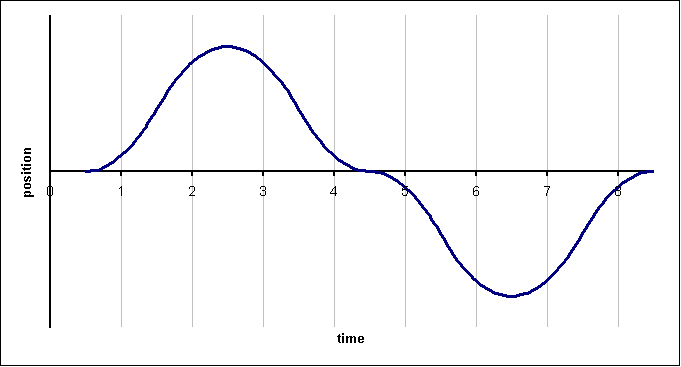Because of the similarity of the definitions of acceleration and velocity, it should be clear that acceleration can be thought of as the slope of a velocity versus time graph, just as velocity is the slope of a position versus time graph. It might not be clear, however, that we can also see the effects of acceleration in a position versus time graph.
null
Consider the position vs. time graph shown above. If you were to lay a ruler along the curve of the graph at the origin, the ruler would have to be horizontal to follow the curve, indicating zero slope. Thus, the velocity is zero at the origin. As you follow the curve, however, the ruler would have to be held at a steeper and steeper angle (see the lines added in the graph below). The slope grows with time, indicating that the velocity is becoming more and more positive (the speed is increasing). This positive change in velocity indicates a positive acceleration. In calculus terminology, we would say that a graph which is "concave up" or has positive curvature indicates a positive acceleration.
null
Deceleration"> Deceleration
AccelerationversusDeceleration"> Acceleration versus Deceleration
In everyday speech, we distinguish between "accelerating" and "decelerating". In physics, both situations are referred to as acceleration (which can be confusing). It is possible to give an exact definition of deceleration, however. Deceleration occurs when the velocity and the acceleration vectors have opposite directions. "Acceleration" in the everyday sense (speeding up) occurs when the acceleration vector and the velocity vector have the same direction. The two cases can be illustrated graphically.
GraphsShowing"Acceleration""> Graphs Showing "Acceleration"
null |
null |
positive acceleration |
negative acceleration |
|---|
Both the graphs that show "acceleration" have slopes that are steepening with time. The only difference is that one of the graphs has a steepening positive slope and the other has a steepening _negative slope.
GraphsShowingDeceleration"> Graphs Showing Deceleration
null |
null |
negative acceleration |
positive acceleration |
|---|
Both graphs showing "deceleration" have slopes that are approaching zero as time evolves. (Again, one has a negative slope and one has a positive slope.)
It is a very common misconception that a negative acceleration always slows down the object it acts upon. This is not true. It is important to note that a graph which has a negative slope approaching zero (slowing down) implies a positive acceleration, and a graph which has a negative slope that is steepening (speeding up) implies a negative acceleration. It may help you to remember that the concavity of the graph specifies the direction of the acceleration.
Check Your Understanding"> Check Your Understanding
By looking at the position versus time graph shown above, determine the following at each of the eight numbered instants of time:
A.) Is the object's position positive or negative?
B.) Is the object's velocity positive or negative?
C.) Is the object's acceleration positive or negative?
D.) Is the object speeding up (accelerating) or slowing down (decelerating)?
Solution
System, Interactions and Model: This exercise is a review of the definitions of position, velocity and acceleration. These concepts are used in several of the models in the hierarchy.
Answers:
